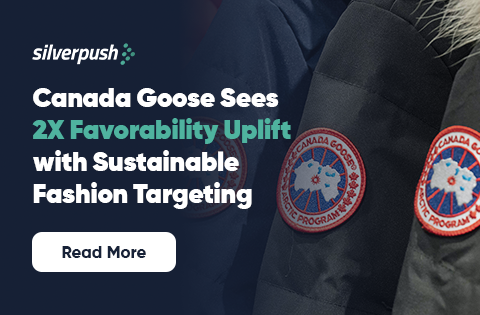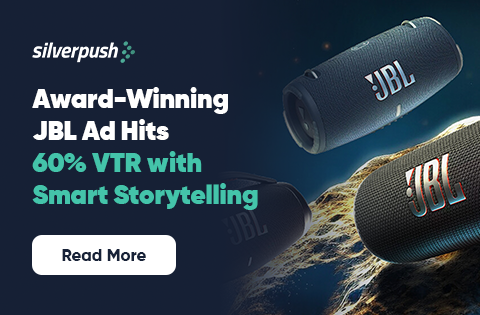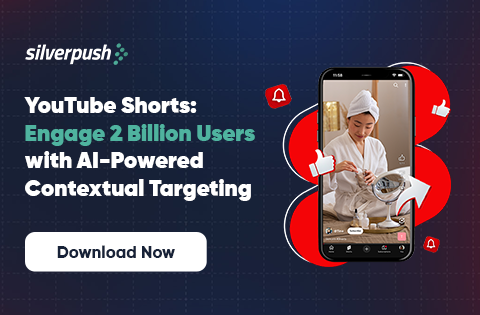Breaking Tradition: Innovative Marketing Strategies for Vietnam Tet 2026
PUBLISH DATE: 01 December 2025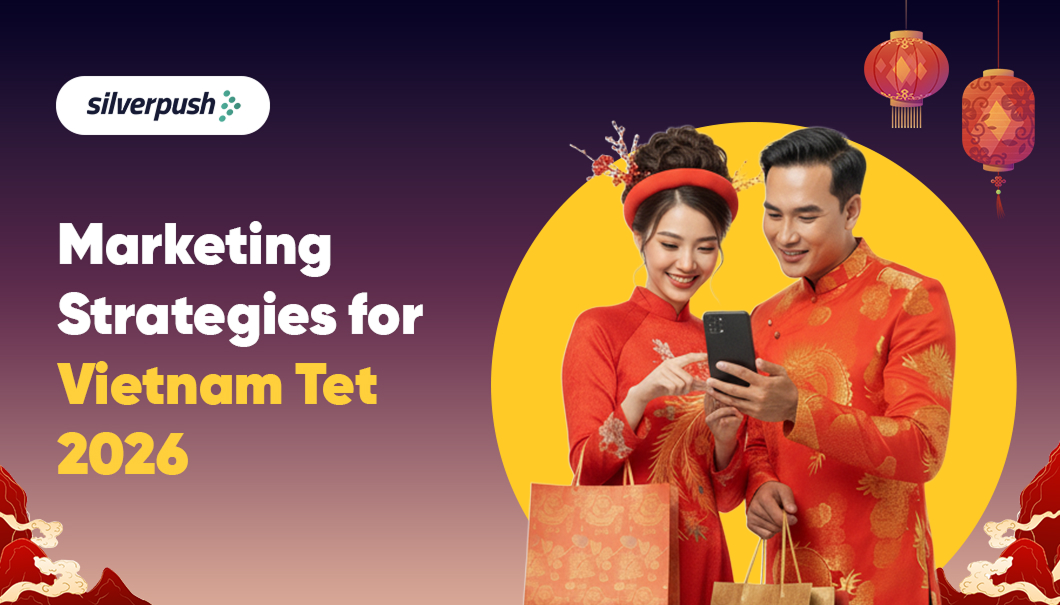
Tet is still the cultural heartbeat of Vietnam. Streets fill with lights, families travel home, and households invest in food, gifts, and rituals that matter. For years, you could rely on the same formula. Run a sentimental family reunion story, wrap products in red and gold, and wait for sales to rise.
Vietnam Tet 2026 is not that simple.
New United States tariffs are putting pressure on the wider economy. At the same time, household spending in Vietnam is still projected to reach around VND 3.85 quadrillion by 2026. Consumer confidence, however, has slipped from 67% to 63% in recent reporting. People still plan to spend during Tet. They are just far more careful about how and where they spend. That shift means your old Tet playbook will not be enough.

Discover Vietnam’s Tet 2026 Consumer Trends
The Economic Reality Behind Tet 2026
The new tariff structure, with standard rates around 20% and higher levels on some transshipped goods, is changing how Vietnamese businesses plan. Consumers feel that pressure. They have not walked away from Tet. They have adapted.
Recent research shows five broad segments in the market. Thrivers, about 20%, have built up savings and feel secure. Unchanged households, around 22%, are keeping the same patterns as before. Cautious consumers, about 15%, still spend but want stronger value proof. Rebounders, around 18%, feel more optimistic about the future. Strugglers, about 16%, are looking for affordable, simple solutions.
You are not talking to one Tet shopper anymore. You are talking to several mindsets at once. People are changing their strategy more than their total commitment. That is reshaping how you should think about budget allocation and creative decisions for the Tet festival 2026.
What Tet 2025 Already Told You
Tet 2025 made a few things very clear.
First, utility won. Premium gift boxes that looked good but did not feel useful lost ground. Shoppers moved toward home appliances, cookware, personal care, and food. Surveys showed that about 26% of consumers cut overall spending, while 63% focused on necessities, 52% on new clothes, and 48% on health-related products. In practice, that means value-led gifts beat decorative items.
Second, shopping started earlier. Around 17% of shoppers began Tet buying at the end of December. If you still launch your main push two weeks before Tet, you are showing up late in the game. People plan earlier, research longer, and touch more platforms before they commit.
Third, the digital landscape is fractured and busy. TikTok has more than 70 million users in Vietnam. Facebook usage covers about 94% of internet users. Zalo is close behind, and YouTube reaches tens of millions. Social commerce is the real shift. With tools like Facebook Shops, Instagram Shopping, and TikTok Shop, people can discover, compare, and purchase without leaving the app. That is now a central part of Vietnam marketing trends for 2026.
How Tet Shopping Behavior Is Changing?
The Tet journey has stretched and now runs across more formats.
The core shopping window is about three weeks, and it moves through a mix of online marketplaces, modern retail, and fast delivery services for last-minute needs. People are more intentional. They look at price, utility, and timing together.
Generational behavior is also splitting more clearly. Gen Z and younger millennials spend more time on TikTok and YouTube. They watch creators, join trends, and respond strongly to short videos and live content. Gen X and Boomers still lean on Facebook and Zalo for information, community, and updates. If you treat all of them the same, your media plan will miss key moments.
Four Strategies for Tet 2026 Campaigns
To keep Vietnam Tet 2026 campaigns relevant, you need a balance of emotion, value, and channel discipline. As we look forward to the next year, brands must adopt a fresh and innovative approach to stand out during Tet 2026.
Let’s look at a few strategies that will maximize the impact of your Vietnam Tet ad campaigns:-
1. Balance emotion with practical value
You can still tell emotional stories, but your offer must feel useful. Shoppers are choosing cooking oil, sauces, pantry essentials, and health-focused products like nuts and yogurt more often. Beer and sweets do not carry the same pull as before. When you design Tet packs, think about larger sizes for better value, smart bundles that people actually finish, and quality that does not feel overpriced. You want people to feel that every item in the gift set gets used.
2. Respect the three-phase shopping journey
The Tet journey has three clear stages. In the planning stage, about three to four weeks before Tet, people look for ideas and inspiration. This is where content on YouTube, TikTok, and other social feeds can shape what they want to buy. In the evaluation stage, one to two weeks before Tet, they compare details, check reviews, and look at prices on e-commerce platforms. In the urgency stage, during the final week, speed and convenience matter most. Fast delivery, clear stock information, and smooth checkout become the main triggers. Your media and messaging should shift with each stage instead of staying the same the whole month.
3. Let each platform do what it does best
Copying the same post across every channel is one of the biggest Tet mistakes. TikTok is strongest for short, entertaining, creator-led content about gift ideas, simple recipes, decoration tips, and real family moments. Facebook is still the main engine for live selling and broad reach, especially for older age groups and family clusters. YouTube is the natural place for longer guides, cooking shows, Tet tradition content, and deeper product explainers that help with serious decisions. If you shape content for what people expect on each platform, your media spend works harder.
4. Lean into social commerce, not just awareness
Shopping through social apps is now normal behavior in Vietnam. If you want to convert, you need more than just awareness videos. Make sure your social shops are easy to use on mobile. Keep payment flows simple. Use live sessions with creators or brand hosts to answer questions in real time. Build small affiliate programs or reward communities that help drive sales. Your work on creative storytelling should connect directly to options that let people buy in the same place.
The Real Tet 2026 Question
Vietnamese consumers have not walked away from Tet traditions. They have adjusted them. Economic pressure has created a more careful and value-focused mindset. People start earlier, compare more, and split their attention across platforms and devices.
The cultural power of Tet is still strong. You will earn attention if you respect that. This year’s Tet festival will belong to brands that deliver real value, use the digital ecosystem of Vietnam with intent, and understand that people want to honor tradition in a way that feels smart and sustainable.
The real question is not whether you should show up for Tet 2026 in Vietnam. The question is whether you are ready to meet your audience in the places and moments where they actually make their decisions.
5 Proven Black Friday and Cyber Monday Marketing Strategies for 2025
PUBLISH DATE: 19 November 2025
You know how Black Friday and Cyber Monday used to be a crazy 48-hour shopping sprint? Those days are over. BFCM has turned into something much bigger. We’re talking weeks of strategic planning, early bird shoppers hunting for deals, people bouncing between online and in-store, and AI helping brands figure out exactly what each customer wants.
And the data backs this up. Silverpush’s Holiday Advertising Playbook 2025 shows that 85% of U.S. shoppers are actively buying during these big sales events. Plus, people are browsing products 37% more than last year, and actual orders are up 14%, according to Klaviyo’s 2025 report. Pretty significant, right?
So if you want your brand to actually break through the noise this year, you need to nail three things: getting ready early, using smart targeting that fits the moment, and telling your brand story in places that are safe and trustworthy. In this guide, we’re breaking down five Black Friday advertising strategies that actually work. Not just for Cyber Week, but for keeping that momentum going long after the holiday dust settles.
1. Launch Early and Extend Beyond the Weekend
The old playbook of launching Black Friday campaigns during Thanksgiving week? That’s not working anymore. Think about it: 59% of shoppers are already starting their holiday shopping before BFCM even kicks off, according to EComposer’s 2025 data. If you’re waiting until late November, you’re already playing catch-up.
You want to start building buzz in late Q3 with your awareness and teaser campaigns. Create exclusive early bird bundles for your loyalty members. This brings in revenue earlier while making your most valuable customers feel special.
And don’t wrap things up right after Cyber Monday. Limited-time extensions and “last chance” offers keep the momentum going and capture sales from shoppers who weren’t ready to buy during the main event. When you engage early and do it genuinely, you’re turning BFCM into an extended campaign that drives revenue well beyond one hectic weekend in November.
2. Prioritize Owned Channels and Repeat Customers
As paid advertising costs keep climbing, smart brands are shifting their Black Friday Cyber Monday strategy toward channels they actually own and control. The numbers from Klaviyo’s 2025 projections tell an interesting story. SMS revenue is jumping by 33%, and repeat customers are bringing in 14% more revenue compared to new customers. This is a real shift in where your BFCM advertising dollars work hardest.
You need to think about your audience in segments based on where they are in their journey with your brand. First-time buyers need different messaging than repeat customers. VIP members expect exclusive treatment that lapsed shoppers don’t. Run early access programs for your most loyal customers. Set up cart abandonment workflows that feel helpful, not pushy.
Email and SMS offer what paid platforms can’t: cost efficiency, data ownership, and deeper customer relationships. Strengthening these channels builds loyalty that survives algorithm changes and ad cost spikes. That foundation becomes critical as you expand into mobile and social channels.
3. Optimize for Mobile and Social-First Commerce
If your Black Friday advertising strategy doesn’t start with mobile first, you’re already behind. Over 70% of BFCM traffic now comes from mobile devices, and social platforms are full purchase destinations now, according to EComposer 2025.
You need mobile-first landing pages with fast load times and one-click checkouts. Create shoppable video content and partner with creators for authentic recommendations. People trust voices they follow more than traditional brand ads.
But winning isn’t just about great creativity. It’s about smarter targeting. Silverpush’s Mirrors solution uses contextual intelligence for TikTok and Meta to place your campaigns where shopper intent is highest, without user tracking. Say you sell athleisure. Mirrors analyzes trends like winter fitness content and places your shoppable ads right next to workout videos from fitness creators. It detects high intent moments and delivers your ad in brand-safe spaces.
Mirrors also removes unsafe content in real time, so your ads stay away from anything controversial. Plus, its automation lets you launch multi-market campaigns in hours instead of days. Your Black Friday campaigns need to work for thumb scrolling and vertical viewing. With smart contextual targeting, you’re showing up at exactly the right moment.
4. Personalize With Context, Not Just History
Personalization has changed completely. Modern consumers expect ads that feel relevant to what they’re doing right now, not just based on past behavior. 2025 data shows AI-driven segmentation is up 75%, with personalized messaging climbing 61%.
Use predictive analytics to spot high-intent shoppers early. But what really matters is delivering ads aligned with the content and mood of the moment. This is where Silverpush’s Mirrors platform comes in. It uses contextual AI to detect signals with varying parameters within video content across YouTube, social platforms, and CTV.
Take YouTube during BFCM. People are watching product reviews and gift guides. Mirrors places your ads where a shopping mindset is already active. A user watching a tech gift guide sees your gadget ad during frames where accessories are discussed. No tracking, no cookies. Just intent matched placement that drives CTR lifts of 230% and search lift of 200%.
On social, Mirrors picks up emerging hashtags and viral topics in real time. When “Holiday Outfit Inspo” spikes on TikTok, it delivers your fashion ads inside those trending streams instantly. For CTV, it scans episodes at the episode level. A viewer watching a holiday cooking show sees your cookware ad during actual cooking scenes. Perfect relevance with zero personal data.
5. Deliver Brand-Safe and Emotionally Resonant Campaigns
Younger audiences prioritize authenticity, sustainability, and safe content. These factors influence whether your Black Friday ads succeed or get ignored. Safety involves not only avoiding risk but also building trust in your brand.
To connect with this audience, combine limited edition product drops with storytelling that reflects your values, creating urgency through scarcity. Develop narratives that resonate through humor, nostalgia, or inspiration while ensuring the surrounding content supports your message. Silverpush’s Mirrors platform ensures your ads appear in safe, emotionally aligned environments across YouTube, TikTok, and CTV, using AI-powered brand safety controls. It filters out unsafe content and creators and analyzes CTV at the episode level to keep your ads away from risky scenes.
Imagine launching a heartwarming Black Friday campaign with your ad featured alongside cozy holiday content instead of controversial material. This approach helps beauty brands avoid problematic creators and ensures children’s brands remain compliant. When customers encounter your campaigns in trustworthy environments, they are more likely to form deeper connections, turning seasonal shoppers into loyal advocates.
Wrapping Up
BFCM is not a weekend anymore. It is a season. The brands that win will not just drop big discounts. They will start early, lean on owned channels, build mobile-first journeys, use AI to match the moment, and keep every placement safe and on-brand. Smarter timing, meaningful personalization, and contextual relevance will separate winners from also-rans.
To shortcut the work, grab the Silverpush Holiday Advertising Playbook for ready benchmarks, a week-by-week launch calendar, creative checklists, and contextual segment ideas you can plug in today.
Best Context-First YouTube Ad Campaigns for the Holidays
PUBLISH DATE: 22 October 2025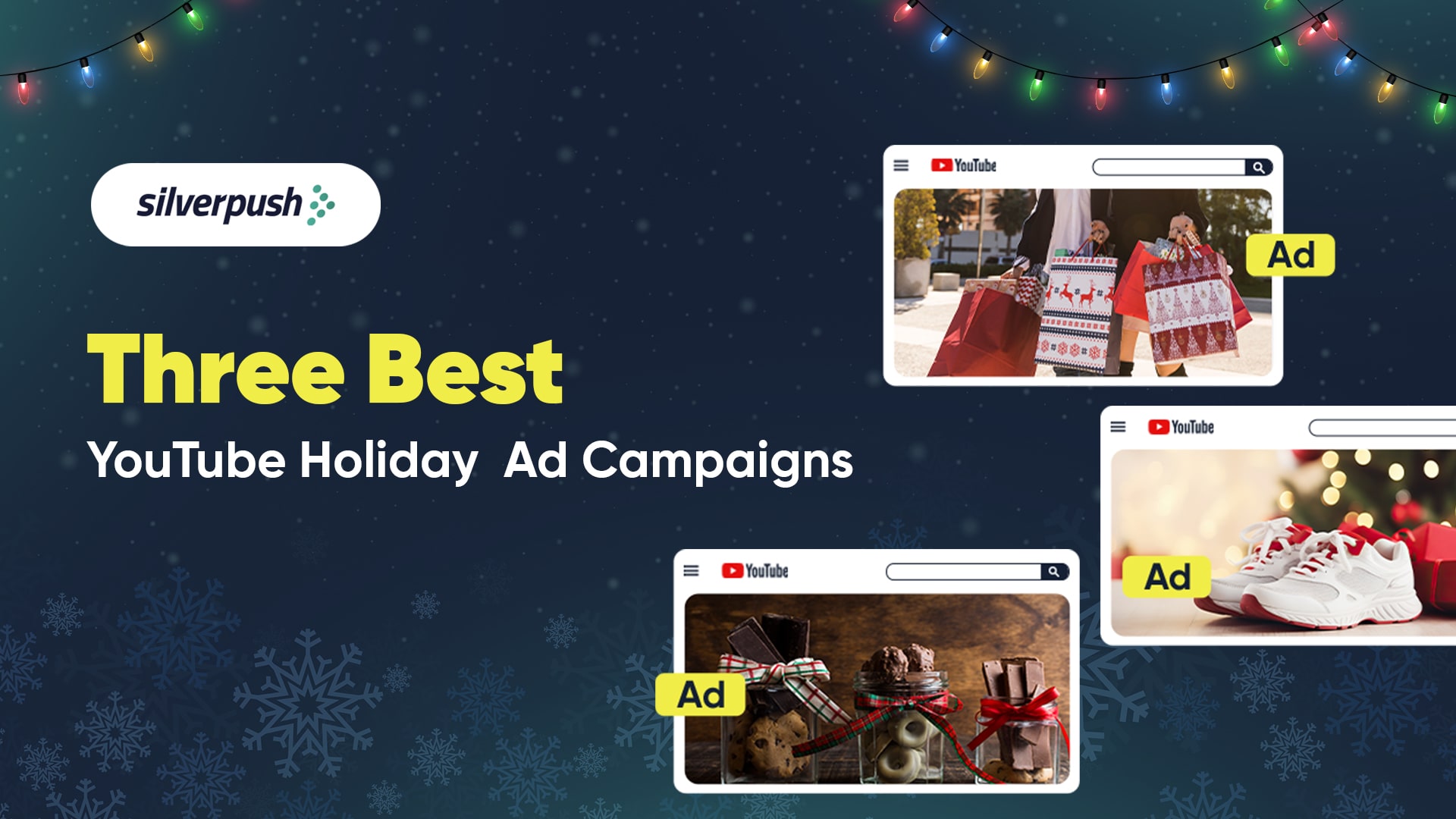
The holiday season is advertising’s biggest stage. Every brand wants to shine, but consumers are flooded with holiday promotions both online and offline. With global online sales projected to reach $1.4 trillion in 2025, the opportunity and the stakes are higher than ever.
For advertisers, the challenge is no longer just visibility. It is about being as relevant as possible at every moment. Shoppers are not only searching for products but also for inspiration. They are constantly switching between tabs, social media channels, videos, and websites before making a decision.
YouTube plays a major role in that journey. Research shows that 93% of viewers say the platform provides everything they need to make a purchase. On YouTube, where every view is a potential touchpoint, the best holiday advertising campaigns are the ones that appear in the right holiday context.
Context-first strategies make all the difference. Instead of being another holiday shopping ad that gets ignored, contextual placements align with what consumers are already watching and turn ads into part of the experience.
The following three case studies highlight how brands used this approach to transform their holiday campaigns into memorable experiences that delivered real results.
1. Sweet Success: A Chocolate Brand Wins Holiday Hearts
During the holiday rush, a major national chocolate brand faced a familiar problem. Competitors were flooding the market with festive deals and seasonal packaging, all vying for a spot in gifting baskets. The brand wanted to connect with consumers on a deeper level than just product promotion, so the team turned to context.
Using Silverpush’s contextual intelligence engine, Mirrors, the brand launched a targeted campaign across YouTube Shorts. Instead of buying ads based on generic holiday videos, ads appeared alongside dessert tutorials, snacking videos, family gatherings, and gift-exchange content. Each creative highlighted themes of sharing and surprise, echoing the emotions people naturally associate with the season.
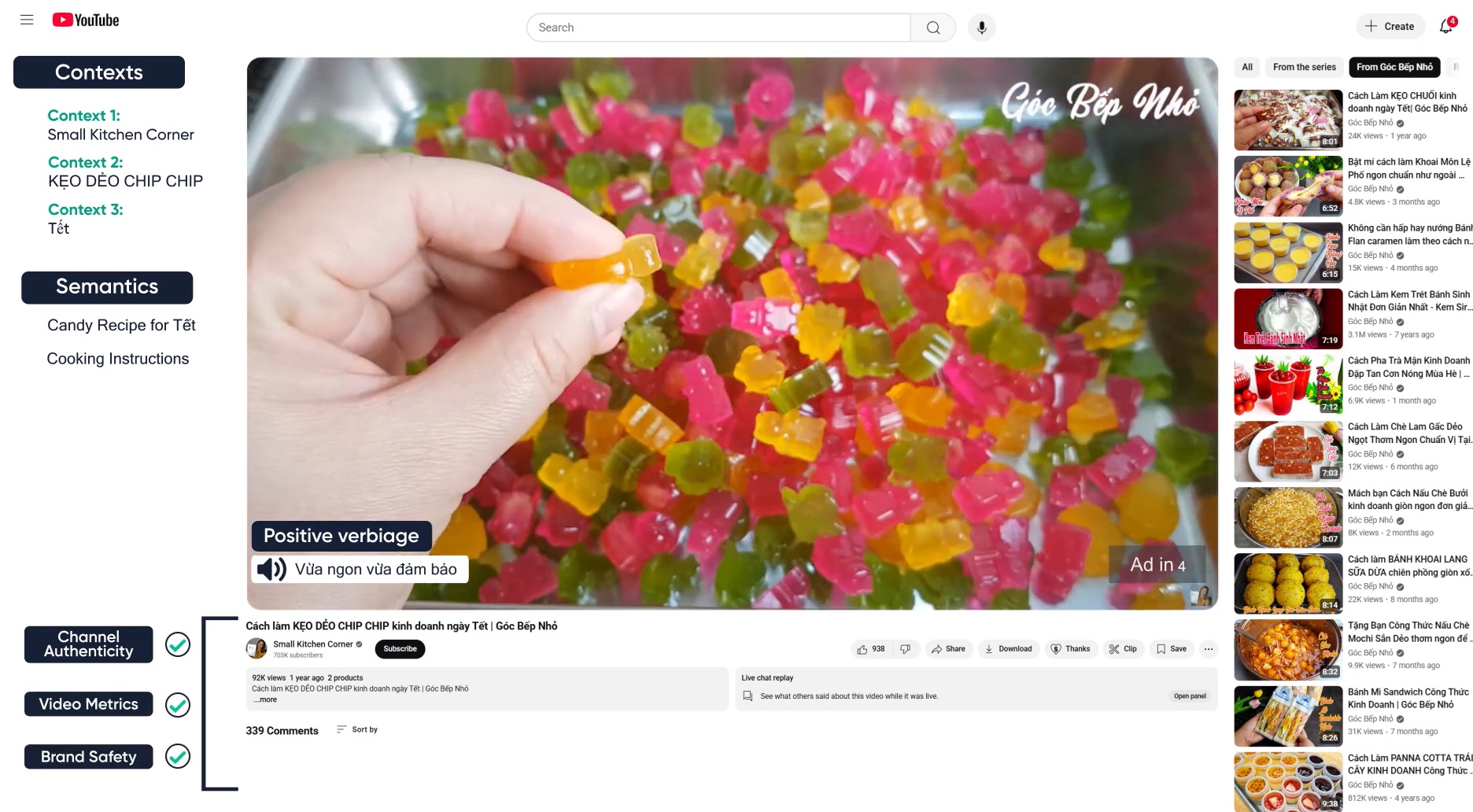
The results proved that relevance wins. The holiday ad campaign delivered a 20% higher CTR than the benchmark and reached more than 847,000 users—an especially strong outcome for YouTube Shorts. By aligning ads with content centered on families and festive traditions, the brand positioned chocolates not as just another promotion, but as part of the holiday experience.
2. Scoring Big: A Sports Brand That Owned Holiday Hype
The sportswear market is highly competitive during the holidays, with consumers often staying loyal to their favorite brands. To break through, one major sportswear brand focused on reaching fans where they were already spending their time and attention: YouTube.
The strategy centered on aligning ads with the most engaging sports content of the Christmas period. By partnering with Silverpush, the brand placed ads alongside videos carrying the right contextual signals, from NFL and NBA highlights to tutorials and creator content. Targeting also included competitor brands like Nike and Adidas, as well as videos featuring brand ambassadors such as Jonathan Taylor and Loren Gabel. To sharpen relevance further, the plan focused on sports actions like dribbling, shooting, passing, touchdowns, and field goals — ensuring ads appeared in the very moments when fans were most engaged with their favorite plays.
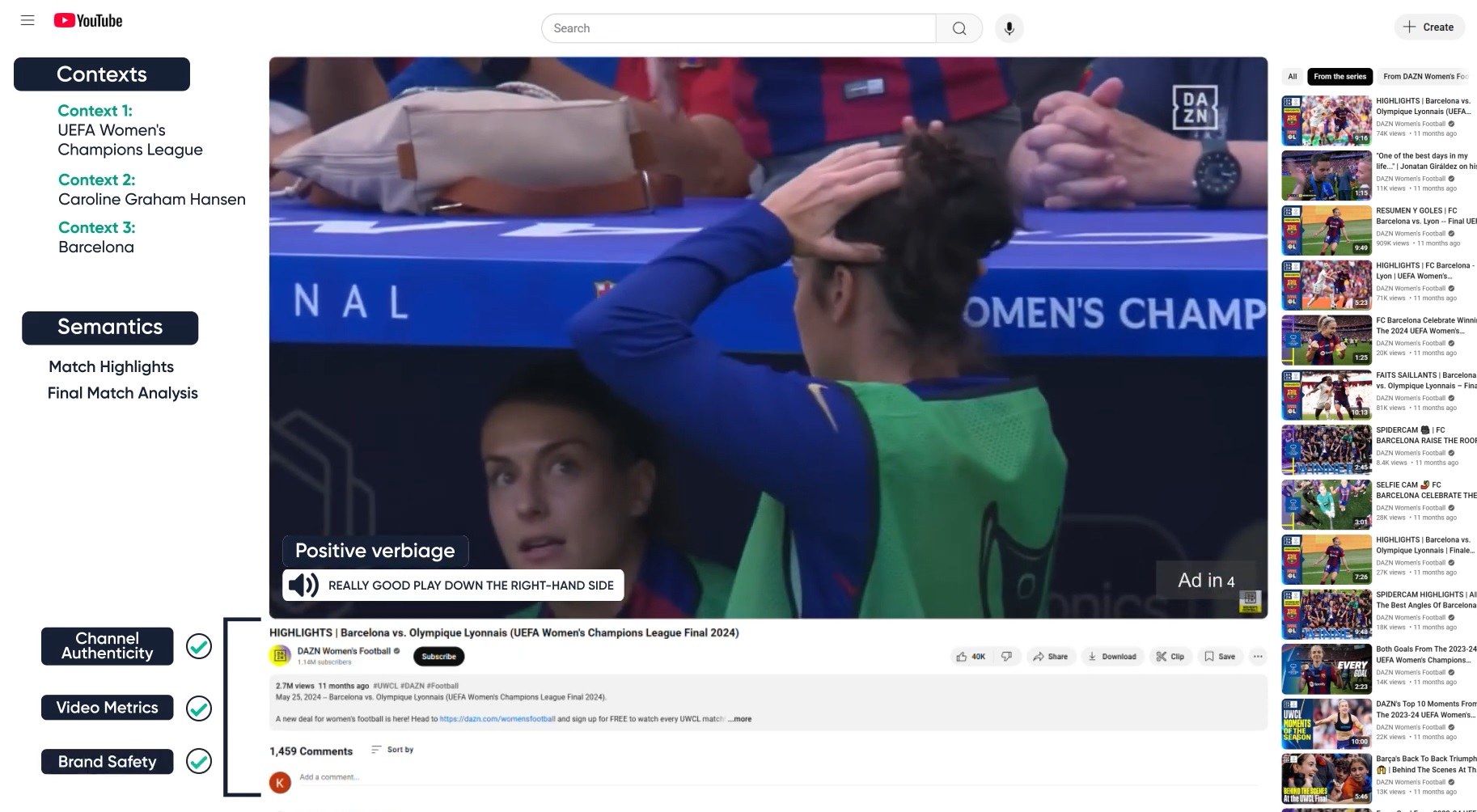
This approach made the brand feel like part of the action rather than an interruption. The results spoke for themselves: a 79% overall VTR and an 81% completion rate on influencer-led placements. In a category where standing out is notoriously difficult, combining holiday campaign moments with contextual intelligence gave the brand a powerful edge.
3. Retailer Magic: Turning DIY Holiday Moments into Measurable Wins
The holiday season is the busiest time for big-box retailers, with countless promotions running both in-store and online. To stand out, this retailer focused on connecting authentically with family-focused shoppers, positioning the campaign as part of holiday planning rather than just another ad.
The context-first approach leaned on trust. By placing holiday ads within YouTube content from lifestyle icons like Oprah Winfrey and mom-focused creators such as Jordan Page, the campaign tapped into voices families already rely on for advice and inspiration. Ads also appeared alongside seasonal content such as Christmas tree decorating, gingerbread house building, and festive meal preparation, ensuring they reached high-intent holiday consumers. To sharpen relevance, the targeting included competitor mentions like Target as well as popular product names such as Lego and American Girl, adding another layer of precision.
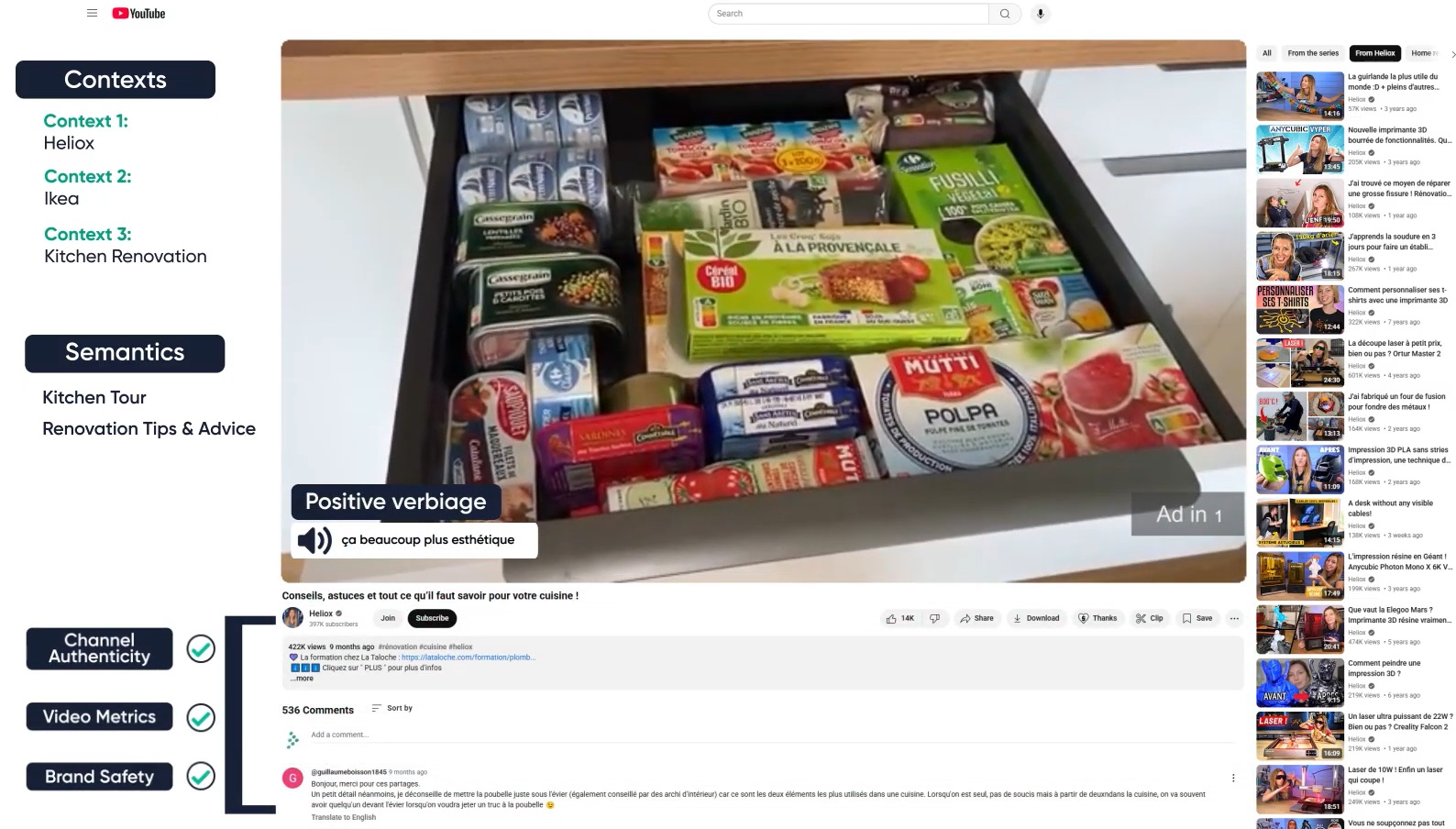
The results highlighted the power of holiday relevance. The campaign achieved a 32% higher VTR than the benchmark and a 30% lower CPV. By blending cultural cues with trusted influencers, the retailer connected with highly engaged consumers, boosted efficiency, and transformed ads into helpful content that supported families as they planned their holidays.
‘Tis the Season for Context
These three campaigns show that the best holiday advertising is not about being louder but about being more relevant. By aligning with seasonal content, cultural triggers, and trusted voices, each brand created ads that felt like part of the experience and part of the celebration.
For marketers preparing for the next holiday rush, the takeaway is clear. The most successful holiday campaigns are not built on creativity or budget alone. By partnering with Silverpush and using contextual intelligence, these brands made their ads connect at the very moments that matter most.
Make context your edge this holiday season. Get the Holiday Advertising Playbook 2025 to discover how to stand out and drive impact that lasts well beyond the holidays. Let’s connect to see how these ideas can power your next campaign.
Holiday Advertising Strategies: How to Use Video Ads to Skyrocket Sales
PUBLISH DATE: 12 September 2025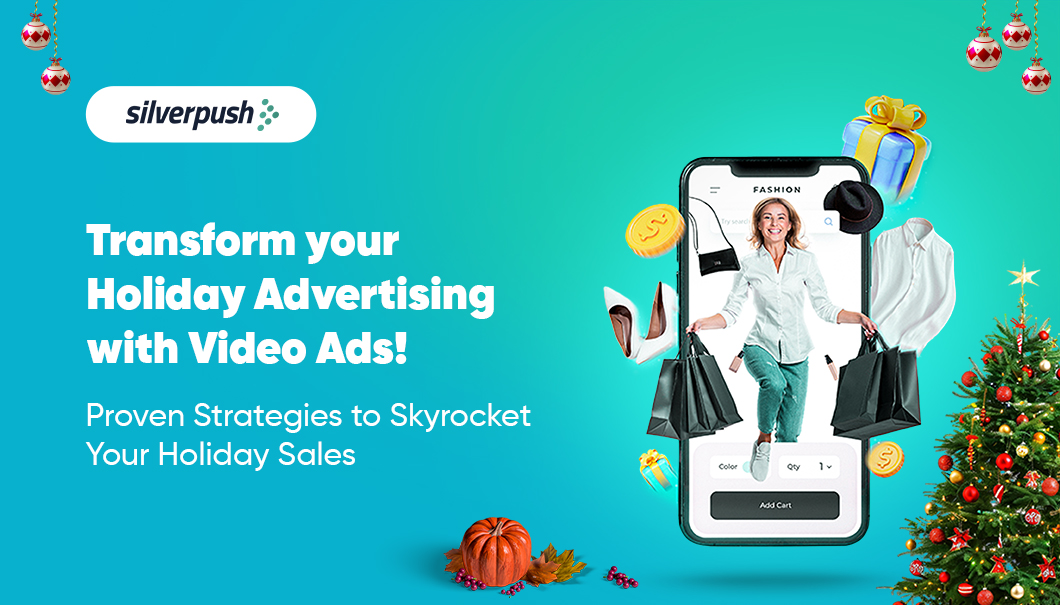
The holiday season is a retailer’s Super Bowl. With shoppers ready to spend and online sales projected to hit $1.359 trillion in 2025, the spotlight has never been brighter. But under the glitter of digital Santas and endless “limited-time offers,” one question looms: how will your brand steal the show?
The answer lies in creating holiday campaigns that do more than sell. They need to inspire, entertain, and connect with shoppers in the moments that matter most. And no format does this better than video. From sparking emotion to showcasing products in action, video advertising has become the go-to play for brands that want to cut through holiday clutter and convert attention into action.
If you’re one of those looking to turn this season into a profit-generating sleigh ride, we’ve pulled together strategies that will help your brand resonate, engage, and ultimately, drive conversions. Before diving into them, let’s take a closer look at why video ads should sit at the heart of your holiday playbook.

2025 Holiday Trends Reveal What Truly Motivates Shoppers – Are Your Campaigns Aligned?
Why Video Ads Are Your Holiday Cheer Squad
Remember those heartwarming holiday commercials that drew you to the TV? There’s a reason brands invested in video then, and it’s the same reason video must remain the cornerstone of your holiday advertising arsenal today.
Emotions Sell
Video allows you to tell stories, spark nostalgia, and stir generosity—the very feelings that define the season. According to the Silverpush Holiday Advertising Playbook 2025, 93% of YouTube viewers say the platform gives them everything they need to make a purchase, with holiday shoppers spending 1.7x more than those who don’t. This shows just how powerful video-driven storytelling can be in nudging purchase decisions.
Think of a classic holiday ad with a family decorating their home: kids hanging ornaments, parents lighting up the tree, and the warmth of a glowing fireplace in the background. A single image doesn’t capture that emotion. Video brings it alive.
Product Show-and-Tell
Videos are like your digital storefront window. They let you demonstrate features, answer questions, and show how your product fits into everyday life. And this season, the momentum is undeniable. Holiday shopping content on YouTube has grown 54% year-over-year, with categories like shopping vlogs (+58%) and product reviews (+54%) fueling intent-rich discovery.
Pair this with the fact that adding videos to landing pages can boost conversions by up to 80%, and the case is clear: video doesn’t just entertain, it drives action. During the holidays, when decisions are faster and baskets are fuller, your video ads can be the difference between being scrolled past and being added to the cart.
Holiday Ad Hall of Fame: Top 3 Holiday Campaigns That Sparkled in 2024
Need some creative fuel? Let’s take a page from the holiday ad 2024 playbooks of these iconic brands:
1. Amazon: Midnight Opus
Amazon’s 2024 holiday ad, “Midnight Opus,” tells the story of a theater janitor whose hidden vocal talent is celebrated by colleagues. With a swift Amazon delivery of a tuxedo jacket, he steps into the spotlight to perform “What the World Needs Now Is Love.”
The results? The campaign was hailed as one of the most uplifting ads of the 2024 holiday season, resonating across markets in the US, UK, and Europe. Viewers praised its emotional storytelling, and the spot drove high engagement across broadcast, cinema, and digital channels, cementing Amazon’s role in turning everyday moments into shared celebrations.
2. John Lewis: The Gifting Hour
John Lewis’s 2024 holiday ad, “The Gifting Hour,” followed Sally on a magical journey through childhood memories and a John Lewis store as she searched for the perfect last-minute gift for her sister. With Richard Ashcroft’s “Sonnet” as the soundtrack and a TikTok contest inviting fans to share their own covers, the campaign blended nostalgia, music, and audience participation.
The results? The ad topped emotional engagement charts in the UK, with 55.5% of viewers reporting a strong positive response, the highest among Christmas campaigns that year. It also lifted organic search for John Lewis by 17% YoY and increased the Net Promoter Score by 10 points. The campaign reinforced John Lewis as the Christmas gifting destination, combining heartfelt storytelling with business impact.
3. Coca-Cola: Holiday Road
Coca-Cola’s 2024 campaign “Holiday Road” reimagined festive storytelling through the lens of artificial intelligence. Short, visually stunning films brought to life snowy landscapes, playful polar bears, and digital renditions of the brand’s most iconic symbols, including Santa and the red trucks. Despite the new medium, the message stayed true to tradition: the journey home is worth it for the people waiting at the end.
The results? The campaign generated millions of views in just weeks, blending TV ads with digital activations such as QR-enabled packs and the famous Truck Tour, which donated up to one million meals through FareShare. While the AI twist sparked debate around warmth versus innovation, it also positioned Coca-Cola at the center of conversations on the future of holiday advertising.
Your Holiday Shopping Ad Battle Plan: Strategies That Deliver
If you’re ready to make this your most successful holiday season yet, here’s your checklist for developing holiday shopping ad campaigns that break through the holiday shopping crowd:
1. Don’t Be a Last-Minute Elf: Start Early!
This year, timing is everything. Holiday shopping kicks off well before the season peaks, with 64% of consumers starting their purchases before Halloween. Shoppers are spreading out their buying cycles, with activity up six points in September, four points in October, and down eight points in December.
For brands, this shift means waiting until Cyber 5 is simply too late. Launching campaigns early gives you the edge to capture deliberate planners while intent is still building. With contextual intelligence solutions like Silverpush’s Mirrors, you can meet these shoppers in the exact moments they are researching, browsing, and planning, ensuring your message lands before the rush.
2. Get Personal: It’s Not You, It’s Me (Your Ads)
Nobody wants to feel like just another name on a mailing list. As 24% of consumers rank personalization as the most important factor for holiday shopping, and 83% of consumers are interested in customized offers. Personalizing your ads based on people’s online behaviors is essential. As cookieless solutions gain traction, AI’s contextual targeting ensures your ads appear in relevant online environments. Innovative video ads can further enhance these personalized messages, making them more engaging.
3. Win Back Those Wandering Shopping Carts
We’ve all been there—loading up those online carts only to get distracted before checkout. Retargeting ads are your best avenue for reminding them about the treasures left behind. You can rekindle the shopping spark with holiday-themed offers, free shipping, and even a discount code. Using Crafters, you can create engaging, interactive retargeting ads that remind customers of what they’re missing, driving them back to complete their purchases.
4. Embrace the Warmth of Nostalgia
There are very few things that tug at the heartstrings like holiday nostalgia. Some real imagery, music, messaging—just delivering up those warm, fuzzy memories: think crackling fireplaces and fresh pine needles with classic holiday tunes playing in your mind.
5. Create a Little (Harmless) Urgency
“Limited-time offer!” “Don’t miss out!” These phrases are music to a shopper’s ears, especially during the holidays. Use limited-time discounts, flash sales, or bundle deals to incentivize those purchases and create a sense of excitement. Remember, 85% of online shoppers keep tabs open, waiting for sales to begin. With Silverpush’s contextual targeting, you can place these urgent offers precisely where they’ll have the most impact, catching potential customers at the perfect moment.
Silverpush’s AI-Powered Holiday Framework
Silverpush’s full-funnel solutions help brands move shoppers from discovery to conversion during the festive rush.
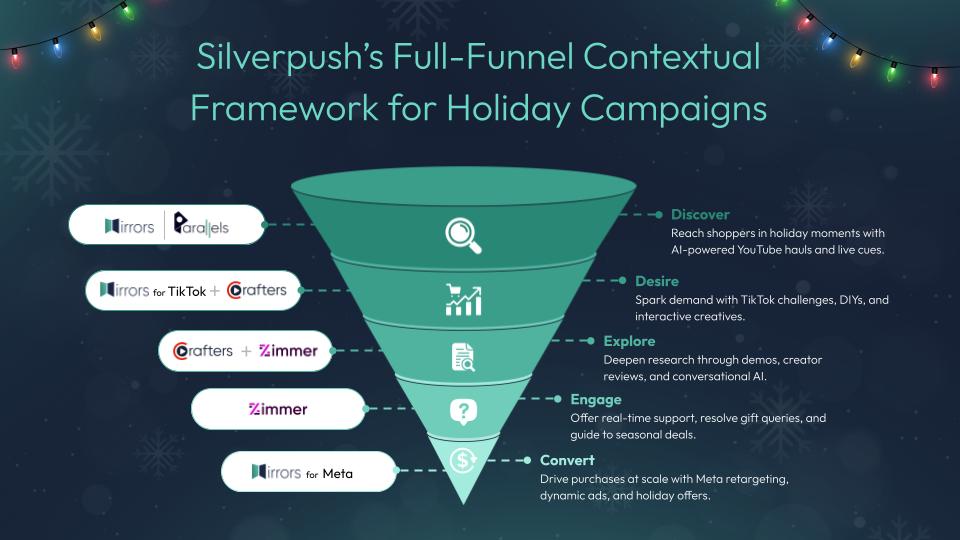
At the top, Mirrors and Parallels ensure ads appear in the right context across YouTube and moment sync. Crafters drive desire with interactive creatives on TikTok and YouTube. As shoppers explore, Zimmer deepens engagement by answering queries in real time and guiding decisions. Finally, Mirrors for Meta powers conversions with retargeting and dynamic offers.
Together, these AI-driven tools minimize wasted impressions and maximize festive impact, making every touchpoint timely, relevant, and effective.
To Sum Up
The holiday season is a prime opportunity for your business to shine. By crafting strategic, engaging, and emotionally resonant ads, you can attract holiday shoppers, build brand loyalty, and watch your sales soar. It’s not just about selling products; it’s about creating memorable experiences and spreading holiday cheer.
Seize the season with advanced tools and strategies to make your holiday campaigns stand out. Start early, personalize, retarget, and embrace the festive spirit. With the right approach, this holiday season can be your most successful yet.
Silverpush Partner Spotlight: Velma Agbodo, Performance Director at Mediahub
PUBLISH DATE: 21 August 2025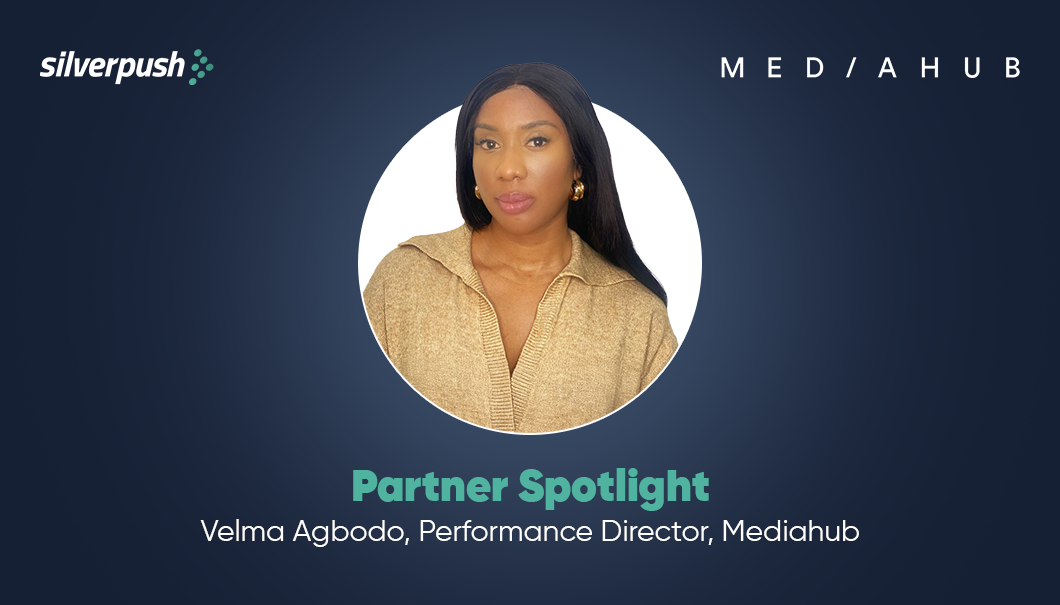
This week, we got the chance to talk with Velma Agbodo, the performance director at Mediahub UK. Velma talked to us about Mediahub, what sets the agency apart, and the big. changes in the market across AI, social media, and more. And the biggest motto from MediaHub: More Pilot, Less Auto.
1. Tell us about your agency. What makes you stand out?
Mediahub is part of IPG, and we stand out because we have a challenger mindset. We’re not satisfied with the status quo and consistently think outside the box. We fully commit to every campaign, empowering our team to deliver their best work. Ultimately, we focus on creating tailored solutions that align precisely with each client’s unique goals, not just following standards, but setting new ones.
This approach is rooted in our belief in More Pilot, Less Auto; we actively steer every campaign with strategic insight and human intelligence, rather than leaving success to chance or automation. At Mediahub, our precise, audience-focused approach enables us to pilot our campaigns, driving meaningful growth and breaking new ground.
2. What made you choose Silverpush as a contextual partner?
When evaluating vendors, Silverpush’s proprietary technology immediately stood out due to its unique ability to analyze video-level content—something truly different in the market. This innovation allows us to deliver more precise targeting and insights for our clients. Additionally, Silverpush is an efficient partner, enabling us to analyze video content quickly while driving significant cost efficiencies.
By partnering with Silverpush, we provide our clients with scalable reach combined with enhanced relevance and improved campaign efficiency, ultimately maximizing their return on investment.
3. Has the market changed recently? What are the biggest trends that you’ve seen with clients?
The market has definitely evolved recently, especially in how clients approach creative formats and content strategies. One of the biggest trends we’re seeing is the widespread adoption of vertical video formats. Shorts and reels have become a staple in the creative mix, allowing brands to engage audiences on platforms like TikTok, Instagram, and YouTube in a more native and immersive way.
Alongside this, influencer partnerships and native-style content are increasingly integral to campaigns. These approaches help brands connect authentically with their target audiences by blending seamlessly into the content consumers are already engaging with.
Another key trend is the rise of connected TV (CTV) as a premium digital channel, offering advertisers new ways to reach audiences with high-quality, engaging video content beyond traditional Linear TV.
Overall, these shifts reflect a move toward more agile, authentic, and targeted media strategies that drive stronger engagement and ROI for our clients.
4. What are some stand-out campaigns that you’ve run this year?
We executed a standout EMEA awareness campaign for a global toy company targeting kids. Our goal was to reach the exact audience of children to build awareness, boost purchase intent, and drive pester power. Using Silverpush’s technology, we were able to contextually target video-level content on YouTube, delivering ads alongside videos our core audience was actively engaging with.
Silverpush’s advanced tech allowed us to analyze for context and visual triggers within the video content, such as competitor branding, ensuring highly relevant ad placements. As a result, we achieved view completion rates (VCR) that exceeded benchmarks across all campaign segments and a positive lift in brand metrics, which we attribute to the strong audience resonance.
5. Have you noticed the impact of AI over the past year? Where have you seen it being used the most?
Yeah, definitely — AI has had a big impact over the past year, especially in media and marketing. One of the biggest things we’ve seen is how social platforms are using AI to automate many processes, like optimising how ads are delivered and who sees them. It’s not just about targeting anymore; the algorithms also help personalise creatives in real time, which makes campaigns a lot more effective.
On the creative side, AI tools are really helping to speed things up, whether it’s generating content, writing scripts, or making different versions for different audiences. Plus, there are media tools that use AI to track attention and behaviour, which gives us better insights to fine-tune campaigns.
That said, it’s still really important for marketers to pilot automation carefully and understand when and how to use it effectively, because the human touch is still key to making sure everything hits the mark.
So overall, AI is making campaigns smarter and more efficient, helping us get better results for clients without all the manual guesswork.
6. What are the biggest ad challenges and opportunities for brands?
One of the biggest challenges brands face today is ad creative. Producing the many iterations needed to ensure messaging resonates with different audiences and fits across various channels and formats can be time-consuming and resource-heavy. Scaling creative while maintaining quality and consistency remains a complex task.
Another challenge is navigating the rapidly changing digital landscape — with evolving privacy regulations and platform algorithm updates, targeting and measurement have become more complicated. Brands also struggle with fragmentation across channels, making it harder to deliver a seamless and coherent customer experience.
That said, there are huge opportunities as well. AI and automation are transforming how we approach creative optimisation, enabling faster iteration and personalisation at scale, which helps campaigns perform better. Data-driven insights give brands the ability to target more precisely and measure effectiveness more accurately than ever before.
Additionally, the rise of new formats like short-form vertical video and immersive experiences, combined with influencer and native content, opens fresh avenues for engagement. Brands that can innovate creatively while leveraging these tools and insights stand to gain a real competitive edge in connecting with audiences meaningfully.
How Brands Use Moment Marketing to Connect with Audiences
PUBLISH DATE: 18 August 2025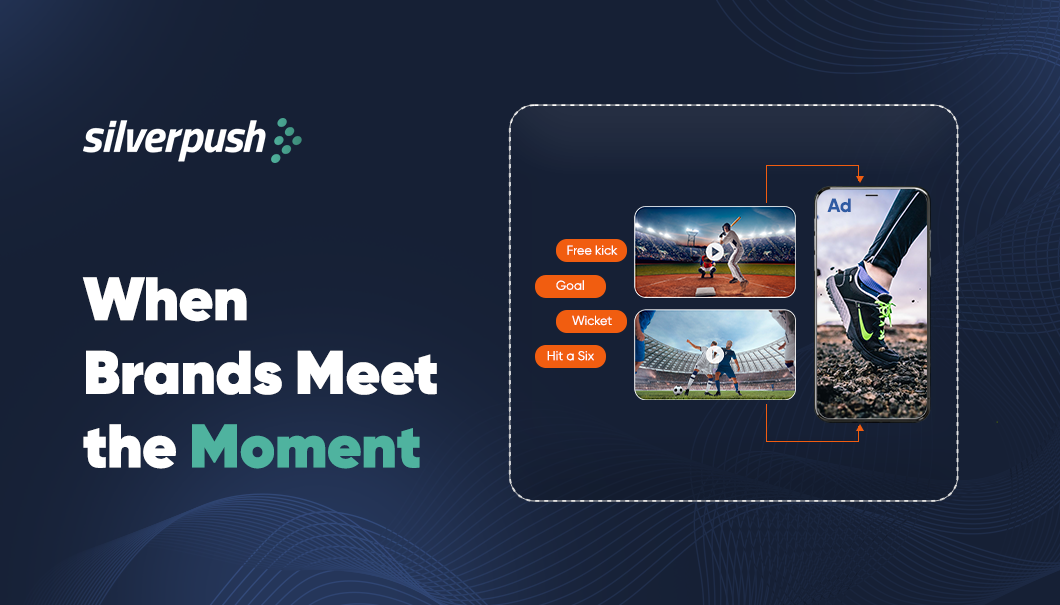
We’ve all been there. You’re scrolling through your feed, and suddenly you see a brand’s take on a trending meme, movie release, or cricket match moment. It’s quick, clever, and somehow, it feels like they read the room just right. That’s not luck. That’s moment marketing.
Over the past few years, moment marketing has moved from being a fun side tactic to something many brands actively build into their strategy. With attention spans shrinking to less than 8 seconds and audiences constantly jumping between screens, being present in the “now” matters more than ever. And the brands that get this are the ones that are starting conversations instead of just pushing campaigns.
Let’s dig into what makes moment-based marketing tick and why it’s working so well.
What is Moment Marketing?
Moment marketing, or real-time marketing, is when a brand rides the wave of what’s trending right now. It could be a news story, a pop culture reference, a weather update, or even a meme that’s blowing up. The idea is to connect your brand with the mood or moment your audience is already tuned into.
What makes it so effective is timing. When you drop a relevant message at just the right moment, it feels less like advertising and more like you’re part of the conversation. People are more likely to engage, share, and remember what you said.
You’ve probably seen brands like Zomato, Netflix India, Burger King, or Amul do this regularly. Whether it’s a tweet after a cricket win or a cheeky visual during a film release, they’ve mastered the art of showing up when the audience is most attentive and most active.
Why More Brands Are Leaning Into It
First, it doesn’t cost a fortune. You don’t need a big production budget to create a tweet or a static creative. What you need is speed, creativity, and timing. That’s a win in today’s cluttered media landscape.
Second, it makes your brand feel real. When people see you engaging with topics they care about right now, it adds personality and relevance. It also shows that your brand is listening, not just broadcasting.
And lastly, it’s a great way to cut through the noise. When something’s trending, people are already paying attention. If your message fits in naturally, you don’t have to fight as hard to be seen.
Making Moment Marketing Work for You
It starts with keeping your ears and eyes open. That means listening to what your audience is talking about, tracking social media trends, and following news cycles that matter to your industry or region.
But it’s not just about reacting to every single trend. You need to know which ones make sense for your brand. A good filter here is asking, “Can we say something meaningful or fun about this without sounding forced?”
Adding a touch of humor helps, but it needs to align with your brand tone. Zomato, for example, brings food into almost every trend they taps into. It’s fun, but it’s still on-brand.
You also want to be careful. Not every moment is meant to be jumped on. Topics around politics, religion, or crises often backfire if handled without context or sensitivity. If in doubt, it’s okay to skip it.
Now Here’s Where It Gets Tricky
While your team might be quick to create a tweet or a reel, your audience isn’t always sitting on one screen. In fact, a study by Think with Google shows that nearly 80% of people use a second screen (like their phone or tablet) while watching TV. Which means, even if you’re running a big TV campaign, you’re probably losing a chunk of attention during ad breaks.
That’s a real challenge. Because what’s the point of a smart, timely campaign if your audience is busy scrolling Instagram while your ad plays?
This is where it helps to think beyond just social posts and tweets. Real moment based marketing happens across screens and, ideally, at the same time. When your brand message shows up at the right moment—on the screen your audience is actually looking at—it doesn’t just get seen. It gets remembered.
How Parallels by Silverpush Changes the Game
If you’re thinking, “How do I even pull that off?” — that’s where platforms like Parallels by Silverpush come in.
Parallels is a real-time moment marketing platform that’s built exactly for this challenge. It detects live moments—like a six being hit during a cricket match, a sudden weather change, or even a trending event—and syncs your digital ad across mobile, CTV, laptop, or tablet right when it matters.
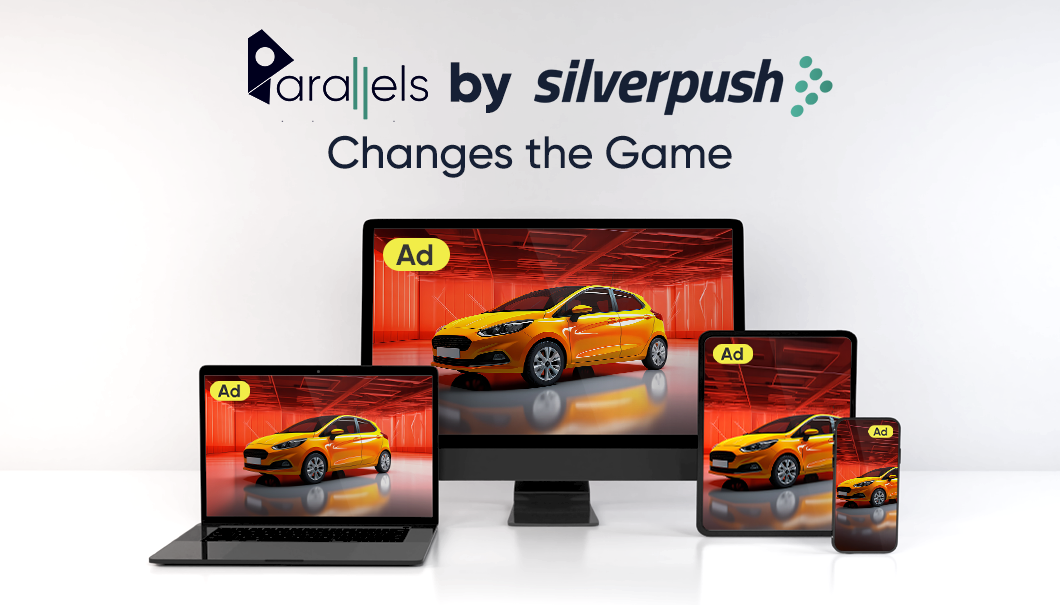
So, let’s say your TV ad runs during a sports break. Parallels picks up on that and instantly displays a contextual ad on your audience’s second screen, based on their interests or location. That could be a sports drink ad during a live match, a skincare product during a pollution alert, or a fashion brand during fashion week.
It’s real-time. It’s cross-device. And it’s driven by AI, so you don’t have to manually chase trends or trigger ads yourself.
[Case Study] How Lucky Me! Captured Rainy Day Moments Using Parallels Weather Sync
Lucky Me!, the Philippines’ leading instant noodle brand, wanted to connect with consumers during the rainy season when cravings for hot, comforting food are at their peak. The challenge was that traditional ads could not react to live weather changes, making it hard to reach people at the right moment.
Using Silverpush’s Parallels Weather Sync, ads were instantly triggered across Meta, TikTok, and OpenWeb whenever rainfall was detected in key regions. This real-time targeting delivered 13.1M impressions, 9.1M video views, a 3.4-point lift in ad recall on Meta, and exceptional VTR gains across all platforms. The campaign proved how aligning media delivery with real-world moments can drive powerful consumer engagement.
Why This Matters for Modern Marketers
If you’re in e-commerce, retail, or media, you already know that attention is fragmented. You can’t rely on one channel to do all the work. Moment marketing with a second-screen strategy gives you that extra edge. It helps you show up not just at the right moment but also on the right screen.
And the best part? It’s not about throwing your logo everywhere. It’s about being part of the experience your audience is already having. That’s what builds trust, engagement, and over time, brand love.
Final Thoughts
Moment marketing isn’t just a trend. It’s how people are experiencing the internet today—in real time, across platforms, while juggling multiple screens.
If your brand can tap into those moments with relevance and speed, you’re not just doing marketing. You’re joining conversations, shaping culture, and building connections that last.
And with a solution like Parallels, you don’t have to just hope your audience sees your message. You’ll know it’s showing up right where and when it counts.
Silverpush Partner Spotlight: Darren Hardeman, VP, Strategy, Media & AI, at PUSH
PUBLISH DATE: 23 July 2025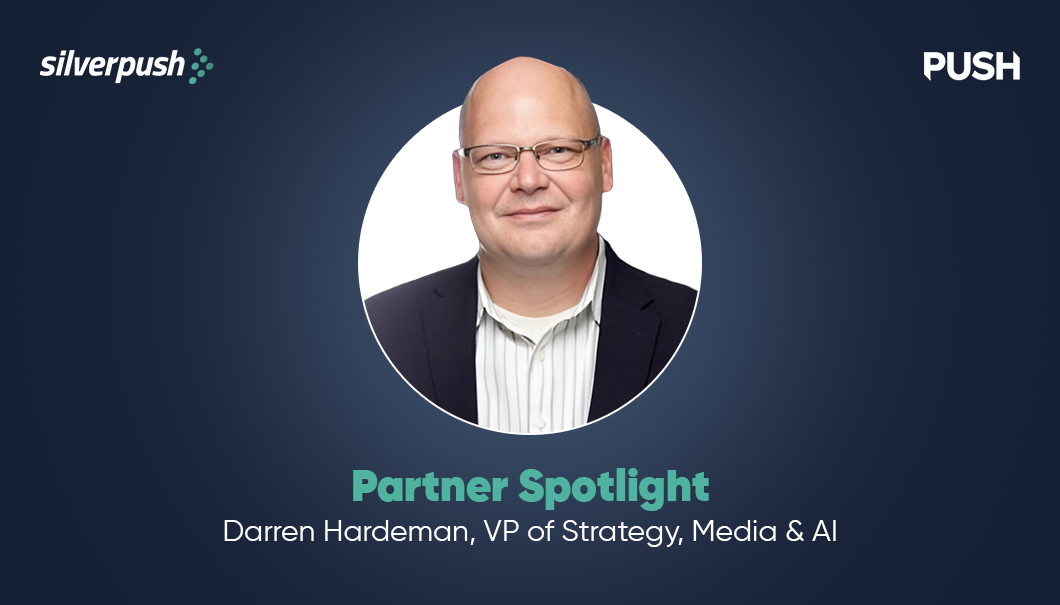
This week, the Silverpush team got a chance to talk with Darren Hardeman, the VP of Strategy, Media & AI, for Canada’s PUSH. PUSH is an indie agency that focuses on connecting media and creative in a new way, driving better results for each campaign and getting the most out of every touchpoint for clients. Darren shared his thoughts about context, the changes in the market, and how brands are successful. Read the full Silverpush Partner Spotlight Q&A below:
1. Tell us about your agency. What makes you stand out?
PUSH started from an idea that ‘wouldn’t everything work better if media and creative were always intertwined?’ So we built an agency model uniting media and creative from the very beginning, ensuring that every campaign message is conceived with purpose, delivered with impact, and measured to maximize outcomes. Feedback loops are built into the process, so all insights, both creative and media, are actioned immediately, maximizing performance today and in the future.
We make it simple and the way it should be: results-oriented, client-focused, and not agency-led or agenda-led.
2. What made you choose Silverpush as a contextual partner?
Anyone can find demographics, geo-targeting, or contextual targeting. Our advertiser partners need more hyper-personalized and addressable targeting. For example, we developed a strategy that used the Silverpush Mirrors product to scan videos to identify signals around the specific themes, brand safety, verifiable behaviors, and semantics of specific niche audiences.
For example, young adults are interested in STEM-related activities. By using Silverpush, we were able to find those specific audiences and align with contextual ad placements at scale. This partnership drove results that showed an increase in engagement and conversion rates because the quality of the audience was at a higher level than previous targeting methods.
3. Has the market changed recently? What are the biggest trends that you’ve seen with clients recently?
We are in a revolutionary period of change in marketing. In the Canadian market, we’re seeing:
- Less easily available data through more informed and skeptical consumers, as well as government regulations.
- More opportunities with increased media fragmentation across platforms.
- A dramatic increase in AI in every aspect of our work, with a different adoption rate depending on each client. Some accept AI-generated work. Others believe in a ‘wait and see when it improves’ approach.
4. What are some stand-out campaigns that you’ve run this year? What made them work?
I would say there are three things that make a campaign stand out:
- Being insight-led in the strategy and data-driven throughout your approach. By addressing objectives through insights about your audiences and using data to meet audiences where they are, we can create better, more meaningful connections for brands.
- Be omnichannel in your selection and approach. Plan and execute across all channels in a connected manner, as that is how our audience(s) will consume them.
- Be relevant in your placements and messaging. By being relevant, your audience will be more apt to relate, engage, recall, and/or respond.
We have used these principles to develop campaigns for our clients. One that comes to mind is a recent campaign for Humber where we developed a full funnel campaign that started with a video-neutral approach to drive awareness among direct and indirect student prospects through TV, CTV, OLV, and Social Video.
Surrounding all key audiences in Transit and DOOH. Then retargeting through display, social, and search channels to drive conversions. Each asset was relevant to the intended audience segment to increase the ad recall, engagement, and ultimately applications (the client’s business KPI).
5. Have you noticed the impact of AI over the past year? Where have you seen it being used the most?
Noticed it – yep, we use it every day. At PUSH, we use AI in almost every aspect of the process.
In media, it is in our advanced analytics like predictive modeling/MMM, our planning process, our buy optimizers (cross channel and within platforms), reporting, and insight generation.
For creativity, we can use it in our video, image, and text generation, allowing us to efficiently address ad fatigue and personalization.
Is it all 100% in all aspects? No, but every time we use it, it does get better.
6. What are the biggest ad challenges for brands? What are the biggest opportunities?
Here are four challenges that we hear from brands:
- ID Signal loss and privacy regulations/restrictions. This leads to complexity and increased tech cost due to needing additional solutions like data clean rooms.
- Overdependence on Walled Gardens. Too much emphasis on advertising on walled gardens drives prices up over time and leads to less transparency and competition in the long term.
- ROI pressure in a Fragmented Landscape. CMOs have to prove their investment is driving incrementality, which means there is more pressure on measurement than ever before.
- Standing out in a Saturated Market. Consumers are ignoring, blocking, and skipping ads. Brands are often wondering: ‘How can we stand out, get noticed, and be memorable?’
The first three challenges are easier to address: brands should increase their tech stack (when appropriate to drive incrementality and value), diversify spend, and implement advanced analytics like media mix modeling. The latter requires creativity, data-driven insights, and an experienced team that really wants to work alongside a marketer as a true partner.
7. What is your advertising hot take?
The world is full of uncertainty, and advertising is no different. But there are always opportunities in uncertain times, because it changes the way people usually respond to current situations. For example, during these uncertain economic times, marketers may see a down market and pull back investment. However, by taking this as an opportunity to invest and grow our share, we will come out ahead in the long term.
Uncertainty also forces us to continuously look for new opportunities and new partners to do more with less – and, of course, new opportunities to be more creative to gain attention, engagement, and conversions.
3 Takeaways from Cannes 2025: From Performance to Relevance
PUBLISH DATE: 01 July 2025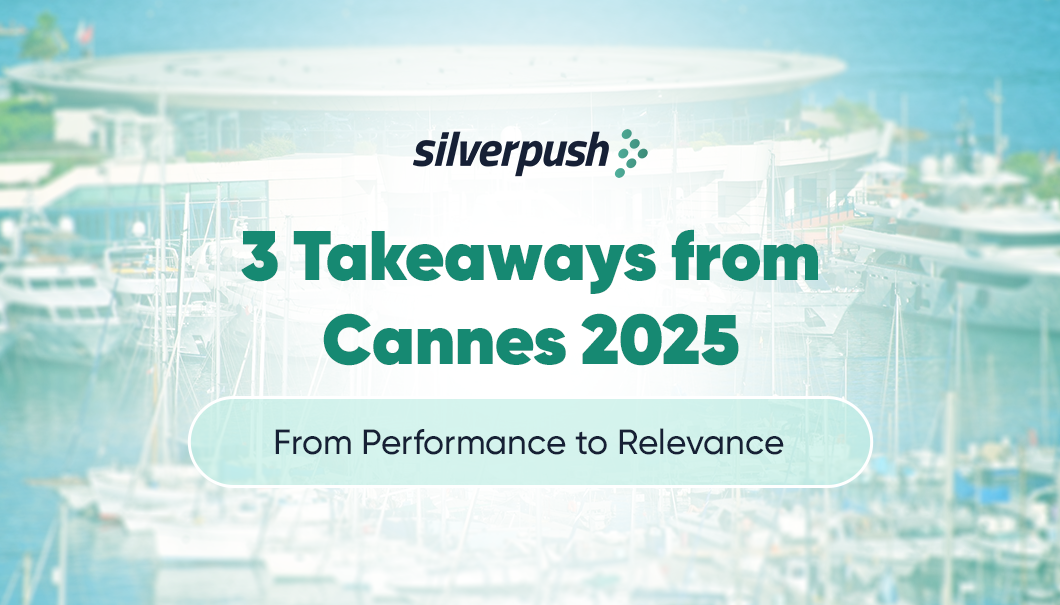
Last month, Silverpush team kicked off the #SummerOfContext in a big way at the Cannes Lions International Festival of Creativity 2025. To start off the week, we launched a brand new contextual targeting solution for TikTok to help brands with brand safety and higher relevance. We also announced our continued expansion into Europe, where Silverpush is growing more than 200% year-over-year and now operates out of seven different countries.
At Cannes, the Silverpush team met with agencies, brands, platforms, and partners to plan for the future of context together. We believe that, in a fragmented attention economy, context is everything – and, with contextual intelligence, advertisers can save money, get higher engagement, and drive better results.
There was a lot to unpack across Cannes, but one thing stood out: with a collaboration-first ecosystem, increasing automation, and advanced attribution, there is a new layer of efficiency and creativity unfolding. AI might just make advertising more human, after all – but we’ll see.
Here’s what the Silverpush team saw as the top three trends at Cannes 2025:-
1. The Era of Performance CTV is Here.
At a panel about CTV on the DoubleVerify yacht, Julie Triolo, SVP of Product Marketing at Fox, explained that convergence is key when thinking about understanding the current measurement maze.
With the right partners, advertisers can start to think about CTV as a full-funnel channel, tracking all the way down to performance. But that doesn’t happen without the right partners. As the CTV ecosystem matures, there’s a proliferation of inventory types like channels, apps, and operating systems that still make transparency difficult. Specific curation and contextual segments, according to the panel, can help with both measurement and targeting.
Want to read more about CTV+curation? Read about Silverpush Pre-Bid CTV Segments.
2. Relevance = Results.
At Cannes, the Silverpush team met up with a lot of brand leaders trying to navigate a fragmented media landscape. One brand leader in charge of a leading candy company explained that the company’s audience was literally “everyone with a mouth.”
After all, just about everyone might be interested in candy at some point in their life. But their individual context – at the moment – is what determines that they’ll be interested. Call it a seasonality of the mood. Especially if you have specific products for specific moments, like chocolate eggs during Easter. The more relevant your ad is to the audience’s current experience, the more likely they are to engage.
Kelly Williams, the Head of Commercial for ITV, said something similar. “About 95% of your audience is not in the market for what you are selling or advertising.”
The solution is relevance.
3. Branding is Making a Comeback.
Despite all the hope that everything that can be measured will be measured, there were also discussions about whether we might have reached the era of peak performance. For many companies, the brand has taken a backseat to the funnel. That might be changing.
“A lot of conversations at Cannes were about how so many marketers seem laser-focused on conversions, but their brands aren’t connecting with consumers,” Jeff Rich, SVP of Americas, says. “When brands take a myopic approach to transaction metrics, they tend to neglect the need for brand building and positioning. But I think the pendulum is swinging back and strategies are becoming better balanced.”
If branding is making a comeback, the other big conversation at Cannes was all about ad creative. As technology converges and allows companies to connect every dot, there’s a chance that the most important thing might become the story itself and telling it the right way, however your audience hears it.
The Silverpush team was thrilled to be on the ground last week to learn and work with everyone else in the industry and to celebrate the #SummerOfContext. Thank you to all the partners and clients who spent time with us last week, and we can’t wait to unveil what’s next for context!
Partner Spotlight: Ben Salaman, Senior Strategist at PB&
PUBLISH DATE: 17 June 2025
1. Tell us about your agency. What makes you stand out?
PB& is a small, independent agency that was founded by people who have spent a lot of their careers in larger agencies. We saw that creativity and efficiency often tend to suffer due to silos, so our founder decided to launch an agency built on a leaner model that would be led by “Thinkers” and “Makers.”
We have a deep bench of senior creatives who can tailor creatives to client and campaign needs. The same core team is on every client call, so we can stay aligned from start to finish, and our clients know what to expect. This allows us to work swiftly and keep things simple and straightforward for our clients. Our team lives and breathes by the ethos that simplicity is the ultimate form of sophistication.
2. What made you choose Silverpush as a contextual partner?
We got introduced to Silverpush, because YouTube is a tough nut to crack. When you traditionally target just by something like interests and demographics, you’re not reaching all the potential audiences who are most likely to be engaged. Considering the amount of content on the platform – low quality, independent, high quality, Shorts, long form, etc – we knew we needed a contextual solution to more precisely target YouTube videos. Silverpush helps us strategically connect with the best audiences in the right moments and gives us more confidence in the video content that we’re targeting and running creative in.
3. Has the market changed recently? What are the biggest trends that you’ve seen with clients recently?
It’s a tighter economy. Clients want to get to the bottom of the funnel quickly.
This is a continuous conversation in the industry now: brand building versus driving performance. But the conversation should always be about brand and performance. You’re not usually going to ask someone to marry you after the first date. That’s why brand building is still important, and building greater brand equity around fandom and community is crucial. The need for this has become even more pronounced, especially since our attention spans have become so fragmented. You still need affinity and emotional connection to resonate, get people to lean in further, and ultimately drive conversions.
Today at PB&, we often think about media mix not as a linear funnel, but as an always-on flywheel and how an ongoing content stream will continue delivering value over time. That’s what builds momentum for the brand and eventually drives more sales and loyalty overall.
4. What are some stand-out campaigns that you’ve run this year? What made them work? (*no need to name clients – more interested in tactics)
One in particular jumps to mind. The Seattle Kraken came to us after they got a less-than-ideal opener slot. When you’re kicking off a season, you generally want to be in a primetime slot. But, the Kraken got 1:30 pm on a Tuesday. So the team knew they needed to build hype to get people to watch the game and pack the arena.
In a market like Seattle, fans are scattered around the city with a tough commute. So the afternoon on a weekday isn’t ideal, especially for a home opener. Kids are in school, and parents are at work. We knew we had to add emotional weight to the game beyond just opening day, so we came up with the creative platform, “ Hooky for Hockey.” We ran media across channels owned and operated by Kraken, local news, social media, and more.
We saw the results on opening day: the arena was sold out, and fans came with signs proudly showing they were playing “Hooky for Hockey.” There was even ESPN coverage, where they mentioned Hooky For Hockey during the live broadcast. Making that campaign become part of the conversation in the hockey world was a big win for the Kraken and really set the tone for the season.
With Silverpush, we’ve focused on driving engagement from viewers for matches throughout the season. We know sports viewing behaviors have changed. Especially with younger demos consuming YouTube Shorts and Instagram Reels, it’s all about the highlights. By using Silverpush Mirrors, we can deliver our ads to specific hockey highlights with messaging that encourages people to tune in live, with campaigns like, “Why watch the highlights when you can see it live?”
5. Have you noticed the impact of AI over the past year? Where have you seen it being used the most?
I think a tidal wave is incoming and people are in for a rude awakening in our industry, not just creative, but across the board. We’re seeing it used in many pockets all around the industry, especially with D2C brands that are relying on AI for high-volume “churn and burn” creative. For mid and lower-funnel tactics, it can be a great tool to optimize targeting and bidding to drive a greater ROI against KPIs. You can churn out a lot of different creatives in tandem to rapidly test, learn, and refine at scale.
You aren’t necessarily beholden to a designer for minor tweaks or improvements. The science of what we do isn’t as bogged down by the time going into the art. But I think this is a crucial topic people get caught up in. There’s clear value to both, and I’m certainly not dismissing the power of creativity. In fact, it’s probably the most crucial ingredient to make this whole AI thing work the best it can… sustainably.
I think we get mistaken about ad creative and AI all the time. This isn’t nor should ever be a replacement for copywriters and art directors. Things might get more realistic as generative AI evolves and improves, but I don’t think AI will have a full understanding of the human condition, like our pain points, desires, and unspoken truths. You can populate AI with data, but you will never find me using the output it gives me for the final creative brief or creative.
Things just can’t resonate with humans if it’s a computer talking to a human or the only thing synthesizing data coming from humans. If you need high-volume (and affordable) output to fuel the engine of your experimentation after you land on a creative platform, that’s where AI can be of service. Not as a replacement. But, everyone should be comfortable with understanding prompting, how the technology works, and most importantly, how to get actionable and inspiring results to improve, not replace, creativity.
6. What are the biggest ad challenges for brands? What are the biggest opportunities?
Fragmentation – and not just in media channels. In communities and culture, IRL and online. I like to think of it as a Rubik’s cube. Add niche communities on top of media fragmentation, and all of a sudden, you have a way more complicated Rubik’s cube, and it’s a tougher puzzle to crack. Finding that perfect audience is like a needle in a haystack, where that haystack isn’t just on one plane or channel – but multiple.
We’ve seen the biggest opportunity is to really focus on building fandom in niche communities by not only showing up in the right environments but also in the right moments to deliver something that is human-first and empathy-first.
7. What is your advertising hot take?
The future is all about the time people spend with you, not the number of eyeballs you get. That’s why relevance is critical and why brands need to show up when and where it matters, but I think as technology advances…, we’re needing to go further and focus conversations around how we can be respectfully relevant. There really is a thing as being too invasive or too creepy when it comes to advertising. That’s when AI’s role in advertising can actually backfire in many ways.
You can’t skip the emotional connection just because you have the tools to get in front of someone right away in an environment you know will convert. Even with millions of targeting inputs and automated optimization, creative will always be the ultimate form of targeting. It’s the glue that melds these points of connection – media is just our vehicle to get it there. That’s why media strategy and creative should always be in lockstep every step of the way in today’s landscape.
How to Win at TikTok Advertising in 2025 With Contextual Targeting
PUBLISH DATE: 09 June 2025
TikTok is no longer just a platform for viral dances and trending audio, it’s now a serious force in the advertising world. With nearly 2 billion users and over 1.8 billion reachable through ads, it’s where your audience is spending their time. But while TikTok delivers unmatched reach, it hasn’t made life easy for advertisers.
You’ve got incredible scale, sure, but also fast feeds, unpredictable placements, and targeting that doesn’t always hit the mark. What worked on other platforms doesn’t work here. Because TikTok isn’t about demographics anymore—it’s about context. And that’s where the real opportunity lies.
Let’s walk through what’s broken in TikTok advertising today, why traditional strategies are falling short, and how a contextual targeting strategy powered by Mirrors for TikTok can help you finally connect.
TikTok’s Scale Is Unmatched—But So Are Its Challenges
There’s no denying TikTok’s power. Users spend over 90+ minutes a day on the app, and it’s become the go-to space for discovery, entertainment, and even shopping. Brands love the exposure, and creators drive trends that can put a product on the map overnight.
But there’s a flip side.
The content feed is highly dynamic and unforgiving. If your ad doesn’t grab attention immediately, it gets swiped past in a heartbeat. The repetition fatigue is real, too—users are consuming so much content in short bursts that stale or irrelevant ads get tuned out fast.
And it’s not just the pace. Ad targeting still lacks the precision you’d get on platforms like Meta. You can’t always isolate your audience or control exactly where your ad lands. So, while TikTok gives you reach, it also makes it harder to stay relevant or safe.
The Limitations of TikTok Advertising Today
Despite all the potential, TikTok’s current ad setup creates friction for marketers. Let’s break down the key challenges:-
1. Ads Are Bundled and Uncontrollable
You can’t just run a “TikTok-only” campaign. Ads are bundled across placements—In-Feed, TopView, and even third-party apps like Pangle. That makes it tough to know where your content will appear or to focus spending on users actively watching short-form TikTok videos. You’re casting a wide net, often without knowing what you’ll catch.
2. Brand Safety Blind Spots
The scroll never stops, and neither does the risk. Your ad might show up between brand-safe videos, but just a few swipes later, it could be adjacent to something completely off-brand—or worse. TikTok has introduced some exclusion tools, but the ever-changing nature of content makes it tough to keep full control over your brand’s environment.
3. Poor Measurement & Context Disconnection
TikTok gives you plenty of performance data – views, impressions, engagement rates- but it doesn’t always tell you why an ad performed the way it did. Was it the content style? The creator? Without deeper, contextual insights, you’re left piecing things together instead of making confident, data-backed decisions.
Mirrors for TikTok: Smarter Targeting Starts With Smarter Context
We understand that running and executing campaigns on TikTok has never been easy. Campaign setups are complex. Trends change by the hour. And content turnover happens too quickly to manage manually.
That’s exactly why we built Mirrors for TikTok.
It’s not just another tool to place ads. It’s an AI-powered, all-in-one solution that helps you launch smarter, stay safer, and actually connect with people, instead of just reaching them. Think of it as your TikTok co-pilot: scanning what’s trending, deciding where your brand fits best, and keeping things optimized in real-time.
Because in short-form, blink-and-you-miss-it environments, context isn’t optional. It’s everything.
So, What Makes Mirrors for TikTok Different?
At its core, Mirrors is designed to help you stop guessing and start growing—faster and more confidently. It’s built on a three-layer AI engine that simplifies every step of your TikTok ad campaign:

Built-In Brand Safety That Keeps Up With TikTok Speed
It’s the ever-shifting content feed that makes TikTok exciting, but also risky. With content shifting by the second, Mirrors adds an extra layer of protection that goes further than TikTok’s default tools. From advanced filters to video-level controls, your ads stay away from unsafe or off-brand content.
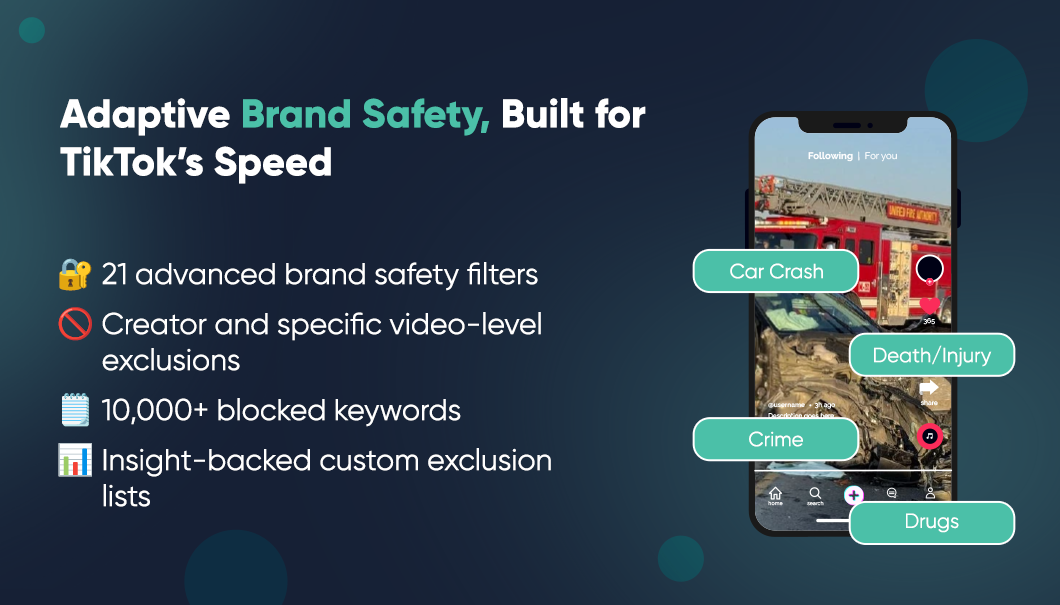
Why Now? Why Context?
TikTok doesn’t wait. New sounds, new formats, new creators—everything evolves overnight. To keep up, your targeting has to evolve too.
Contextual AI gives you the flexibility and precision you need to adapt in real time. It helps you stay relevant without needing personal data, which also checks the box for privacy-conscious users and brands.
And with 2025’s advertising landscape putting more weight on relevance, safety, and privacy, contextual targeting isn’t just a nice-to-have. It’s your edge.
Ready to Win TikTok in 2025?
If you’ve been struggling with limited targeting, poor brand alignment, or underwhelming campaign results, it’s time to try something different.
With Mirrors for TikTok, your brand doesn’t just show up—it fits in.
This is how you stop chasing trends and start riding them.
Contact us to see how smarter targeting can drive better outcomes.


